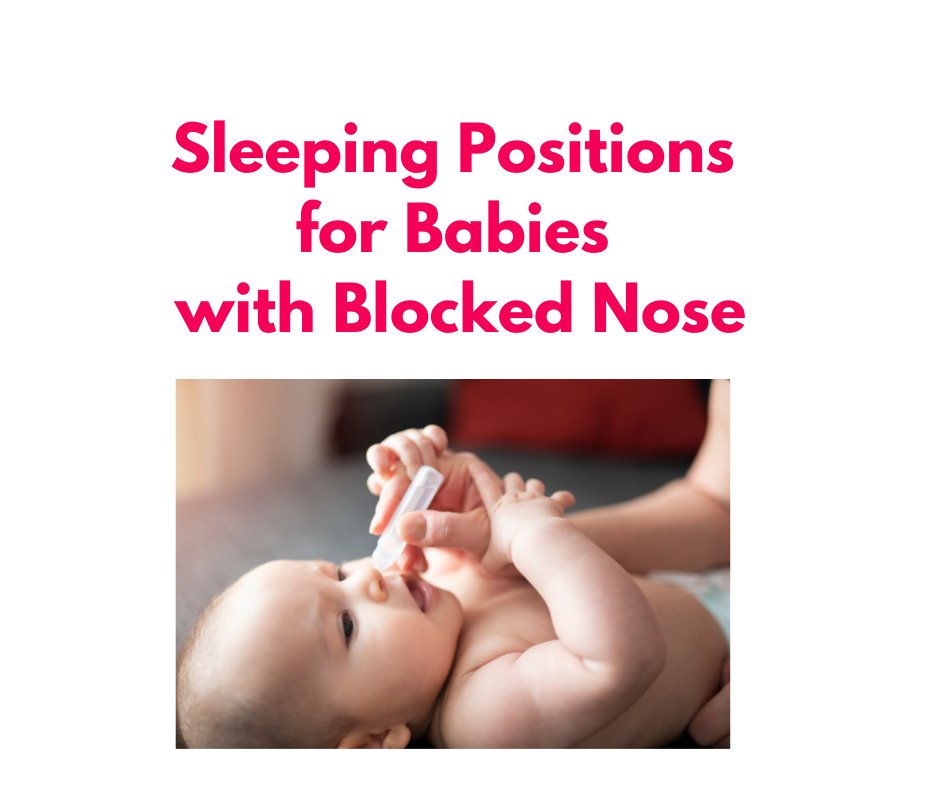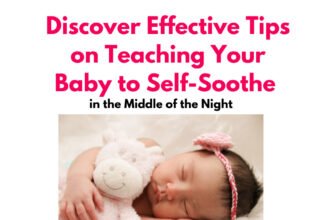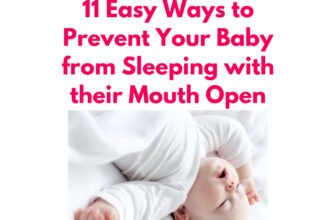
When your baby has a blocked nose, it can be challenging to help them sleep comfortably. Our guide provides tips on the best sleeping positions for babies with a congested nose, including elevated positions and other remedies to clear congestion. Improve your baby’s sleep quality and overall comfort with our helpful tips.
As a parent, there’s nothing more stressful than seeing your baby struggling to breathe, especially when they’re trying to sleep. A blocked nose is a common problem in infants that can make it difficult for them to get the rest they need. Fortunately, there are simple yet effective sleeping positions that can help alleviate congestion and make your baby more comfortable. In this article, we’ll explore some of the best sleeping positions for babies with blocked noses and share some other tips to help you and your little one get a better night’s sleep.
Also Read – How Much do Newborns Sleep (Decoding Newborn Sleep)
Sleeping Positions for Babies with Blocked Nose: Tips for Clearing Congestion
When your baby has a blocked nose, it can be incredibly frustrating for both you and your little one. Sleep is crucial for a baby’s growth and development, so it’s essential to help them get the rest they need.
Here are some sleeping positions for babies with blocked noses that can help alleviate congestion and promote better sleep.
Elevate the Head
Elevating your baby’s head slightly can help clear their nasal passages and make it easier for them to breathe. You can do this by placing a rolled-up towel or blanket under the head of their mattress, or by using a wedge pillow specifically designed for babies.
We recommend the Baby Wedge Pillow from Boppy, which has a gentle incline to help relieve reflux and congestion. If you are in India, use the The “LuvLap Memory Foam Baby Head Shaping Pillow” is a popular option. This pillow designed to elevate your baby’s head during sleep and help alleviate congestion

Side Sleeping
Placing your baby on their side can also help clear their nasal passages and make breathing easier. However, it’s important to make sure they are not lying on their stomach as this can increase the risk of SIDS. The Snuggle Me Organic Lounger is an excellent product for side sleeping, providing a cozy and secure space for your baby.
Also Read – 10 Proven Techniques to Soothe and Calm Your Colicky Baby for a Good Night’s Sleep
Hold Your Baby Upright
Holding your baby upright can help gravity pull the mucus down and out of their nose, making it easier for them to breathe. You can do this by holding them in a carrier or baby wrap, or by using a baby rocker or bouncer. This rocker is a versatile and affordable option that can be used from infancy to toddlerhood.
Also Read – Top 20 Proven baby care tips for new moms: Expert Advice for a Smooth Parenting Journey
Use a Humidifier
Dry air can exacerbate a baby’s congestion, so using a humidifier in your baby’s room can help keep the air moist and make it easier for them to breathe. The TaoTronics Cool Mist Humidifier is a quiet and easy-to-use option that provides up to 30 hours of continuous mist.

The “Dr Trust Home Spa Luxury Cool Mist Dolphin Humidifier” and the “Honeywell HUL535B Cool Mist Humidifier” are two popular options available on Amazon India that can help add moisture to the air and reduce dryness and irritation in your baby’s nasal passages.
Use Nasal Strips
Nasal strips can be used on babies as young as 6 months old to help open up their nasal passages and reduce congestion. Breathe Right Extra Strength Nasal Strips are an effective option for babies, providing relief for up to 12 hours.
Also Read – How can I help my baby sleep through the night?
Warm Compress
A warm compress can help relieve your baby’s nasal congestion by reducing inflammation and opening up their airways. You can use a warm, damp washcloth or a microwavable warm pack, such as the Warmies Microwavable Plush Animals, which can also provide comfort and security for your little one.
Steam Bath
A steam bath can also help relieve your baby’s congestion by opening up their airways. You can create a steam bath by running a hot shower and sitting with your baby in the bathroom for 10-15 minutes. The FridaBaby 3-in-1 Humidifier with Diffuser and Nightlight also has a steam feature that can provide a soothing and effective steam bath for your baby.
Also Read – How Much Sleep Does a 4-Month-Old Need? Expert Recommendations and Tips for Parents
Use Essential Oils
Essential oils can be used in a diffuser or added to a warm compress to help relieve your baby’s congestion. Eucalyptus and peppermint essential oils are both effective for clearing the airways and reducing congestion. However, it’s important to use essential oils safely and to dilute them properly for use on babies. The Plant Therapy KidSafe Wellness Sampler Set includes essential oils specifically formulated for babies and children.
Keep Your Baby Hydrated
Staying hydrated can help thin out mucus and make it easier for your baby to clear their airways. Offer your baby frequent feedings of breast milk or formula, and if your baby is old enough to drink water, offer small amounts throughout the day.
Use a Nasal Aspirator
A nasal aspirator can help remove mucus from your baby’s nose and relieve congestion. The Baby Nasal Aspirator by FridaBaby is a popular option that uses a tube and mouth suction to clear out your baby’s nose. It’s important to follow the manufacturer’s instructions carefully and to use the aspirator gently to avoid injuring your baby’s delicate nasal tissue.

The “Nasobuddy Baby Nasal Aspirator” and the “Nosefrida Nasal Aspirator” are two popular options available on Amazon India that can help you safely and gently remove mucus from your baby’s nose.
In addition to these sleeping positions, there are other remedies that can help clear your baby’s congestion, such as saline drops and suctioning devices. The NoseFrida Snotsucker is a popular and effective suction device that allows you to clear your baby’s nose without the risk of hurting them.
Remember, if your baby’s congestion persists or worsens, it’s important to consult with a pediatrician. These sleeping positions and remedies can provide temporary relief, but they are not a substitute for medical advice or treatment. With a little patience and some helpful products, you can help your baby breathe easier and get the rest they need.
Also, it’s important to monitor your baby’s breathing and to consult with a pediatrician if their congestion persists or worsens. These sleeping positions and remedies can provide temporary relief and help promote better sleep for both you and your baby.
Also Read – 15 Expert-Recommended Baby Safety Tips to Keep Your Little One Safe at Home
Best sleeping position for baby with stuffy nose
When a baby has a stuffy nose, finding a comfortable sleeping position can be challenging. Here are some tips to help you determine the best sleeping position for your baby:
- Elevate the head: Place a rolled-up towel or small pillow under the head of the crib mattress to elevate your baby’s head slightly. This can help to alleviate congestion and make breathing easier.
- Side position: When babies sleep on their sides, it can help to clear their airways and improve breathing. However, it is important to make sure that your baby is positioned correctly and does not roll onto their stomach. You can use a rolled-up towel or a specially designed sleep positioner to help keep your baby in place.
- Use a humidifier: Adding moisture to the air can help to alleviate congestion and make breathing easier. Consider using a cool mist humidifier in your baby’s room, especially during dry winter months.
- Consult with a healthcare provider: If your baby is experiencing persistent congestion or difficulty breathing, it’s important to consult with a healthcare provider. They can provide guidance on the best sleeping position and recommend any additional treatments or medications that may be necessary.
Overall, finding the best sleeping position for a baby with a stuffy nose may require some trial and error. Remember to prioritize your baby’s comfort and safety, and seek medical attention if you have concerns about their breathing.
Is it safe to elevate a baby’s head while sleeping?
Yes, it is safe to elevate a baby’s head while sleeping, as long as you do it properly. It’s important to use a firm, flat surface such as a crib mattress, and to elevate the mattress at the head end by no more than 30 degrees.
The Baby Delight Snuggle Nest Harmony Portable Infant Sleeper is a great option that allows you to safely elevate your baby’s head while keeping them close by.
Can a humidifier help with baby’s blocked nose?
Yes, a humidifier can help with a baby’s blocked nose by adding moisture to the air and reducing dryness and irritation in the nasal passages. The TaoTronics Humidifiers for Bedroom is a popular option that can be used in your baby’s room to provide a steady stream of cool mist.
How can I clean my baby’s nose without hurting them?
You can clean your baby’s nose without hurting them by using a nasal aspirator or saline drops to loosen mucus and suction it out. The NoseFrida The Snotsucker by FridaBaby is a gentle, effective option for removing mucus from your baby’s nose, while the Little Remedies Saline Spray and Drops can help loosen and clear out stubborn mucus.
Can essential oils help with baby’s congestion?
Yes, essential oils such as eucalyptus and peppermint can help with baby’s congestion by clearing the airways and reducing inflammation. However, it’s important to use essential oils safely and to dilute them properly for use on babies.
The Plant Therapy KidSafe Wellness Sampler Set includes essential oils specifically formulated for babies and children.
The “Organix Mantra Eucalyptus Essential Oil” and the “Peppermint Essential Oil” by Allin Exporters are two popular options available on Amazon India that can be used to relieve your baby’s congestion when used safely and diluted properly.
How can I help my baby sleep at night with a stuffy nose?
A stuffy nose can make it difficult for babies to sleep comfortably through the night. Here are some tips to help your baby sleep better when they have a stuffy nose:
- Keep the air moist: Dry air can make congestion worse, so use a humidifier in your baby’s room to keep the air moist. A cool mist humidifier is typically the safest option for babies.
- Use saline drops: Saline drops can help to loosen mucus and make it easier for your baby to breathe. You can use a bulb syringe to suction out any excess mucus after applying saline drops.
- Elevate the head: Use a rolled-up towel or small pillow to elevate the head of your baby’s crib mattress. This can help to improve breathing and alleviate congestion.
- Offer plenty of fluids: Make sure your baby is getting enough fluids to help thin out mucus. Offer breast milk, formula, or water if your baby is old enough.
- Use a nasal aspirator: A nasal aspirator can be used to remove excess mucus from your baby’s nose. Make sure to follow the instructions carefully and sanitize the aspirator after each use.
- Consider medication: If your baby’s congestion is severe or persistent, your doctor may recommend medication to help relieve symptoms. Always consult with your healthcare provider before giving your baby any medication.
Remember, it may take some time for your baby to adjust to sleeping with a stuffy nose. Be patient, and continue to monitor their breathing and comfort level.
What position should a congested baby sleep in?
A congested baby may have difficulty breathing, so it is important to choose a sleeping position that promotes clear airways and reduces the risk of suffocation. Here are some safe sleeping positions for a congested baby:
- Back sleeping: The American Academy of Pediatrics recommends that babies sleep on their backs to reduce the risk of sudden infant death syndrome (SIDS). This position can also help to keep the airways clear and reduce the risk of suffocation.
- Elevate the head: Use a rolled-up towel or small pillow to elevate the head of your baby’s crib mattress. This can help to improve breathing and alleviate congestion.
- Side sleeping: Some parents find that side sleeping can help to clear a congested baby’s airways. However, it is important to make sure that your baby is positioned correctly and does not roll onto their stomach. You can use a rolled-up towel or a specially designed sleep positioner to help keep your baby in place.
Remember to always place your baby on a firm, flat surface and avoid soft bedding, pillows, and other items that could pose a suffocation hazard.
How can I unblock my baby’s nose naturally?
A stuffy nose can be uncomfortable for babies and make it difficult for them to breathe. Here are some natural ways to help unblock your baby’s nose:
- Saline drops: Saline drops can help to loosen mucus and make it easier to remove. Place a few drops of saline solution in each nostril, wait a few seconds, then use a bulb syringe to suction out the mucus.
- Steam: Steam can help to loosen mucus and ease congestion. Run a hot shower and sit in the bathroom with your baby for a few minutes, or use a cool mist humidifier in your baby’s room to add moisture to the air.
- Elevate the head: Use a rolled-up towel or small pillow to elevate the head of your baby’s crib mattress. This can help to improve breathing and alleviate congestion.
- Breast milk: Breast milk contains antibodies that can help to fight off infections and ease congestion. If your baby is breastfed, try nursing more frequently to provide additional antibodies.
- Warm compress: Place a warm, damp washcloth over your baby’s nose and forehead to help loosen mucus and ease congestion.
- Stay hydrated: Make sure your baby is getting enough fluids to help thin out mucus. Offer breast milk, formula, or water if your baby is old enough.
Will my baby be OK sleeping with a stuffy nose?
A stuffy nose can make it difficult for a baby to breathe, which can be uncomfortable and concerning for parents. In most cases, a baby with a stuffy nose will be able to sleep comfortably with some simple interventions to help unblock their nose. However, if your baby is experiencing severe congestion or is having trouble breathing, it’s important to seek medical attention right away.
Here are some signs to look out for:
- Rapid breathing
- Flaring nostrils
- Retractions (when the skin between the ribs pulls in during breathing)
- Wheezing or whistling sounds while breathing
- Refusal to eat or drink
- Lethargy or extreme fussiness
If you notice any of these signs, it’s important to contact your healthcare provider or take your baby to the emergency room right away.
Does breastmilk help stuffy nose?
Yes, breastmilk can help to alleviate a stuffy nose in babies. Breast milk contains antibodies that can help to fight off infections and reduce inflammation, which can help to ease congestion and make it easier for your baby to breathe.
Breast milk can be administered in different ways to help with stuffy noses. One way is to simply breastfeed your baby more frequently, as the act of nursing can help to stimulate the release of nasal mucus. Additionally, some parents find that expressing a few drops of breast milk and placing it in the baby’s nostrils can help to loosen mucus and ease congestion.
While breast milk can be helpful in alleviating congestion, it is important to remember that it is not a substitute for medical care if your baby is experiencing severe congestion or other respiratory symptoms. If your baby is having trouble breathing, is experiencing rapid breathing, or is showing signs of lethargy or extreme fussiness, it’s important to seek medical attention right away.
How do you clear a baby’s blocked nose?
A blocked nose can make it difficult for a baby to breathe comfortably and can cause distress. Here are some steps you can take to help clear your baby’s blocked nose:
- Saline drops: Saline drops can help to loosen mucus and make it easier to remove. Place a few drops of saline solution in each nostril, wait a few seconds, then use a bulb syringe to suction out the mucus.
- Steam: Steam can help to loosen mucus and ease congestion. Run a hot shower and sit in the bathroom with your baby for a few minutes, or use a cool mist humidifier in your baby’s room to add moisture to the air.
- Elevate the head: Use a rolled-up towel or small pillow to elevate the head of your baby’s crib mattress. This can help to improve breathing and alleviate congestion.
- Breast milk: Breast milk contains antibodies that can help to fight off infections and ease congestion. If your baby is breastfed, try nursing more frequently to provide additional antibodies.
- Warm compress: Place a warm, damp washcloth over your baby’s nose and forehead to help loosen mucus and ease congestion.
- Use a nasal aspirator: A nasal aspirator can help to remove excess mucus from your baby’s nose. Gently insert the tip of the aspirator into your baby’s nostril and suction out the mucus.
Do babies drink less milk when they have a cold?
It is not uncommon for babies to drink less milk when they have a cold. A stuffy or runny nose can make it difficult for babies to breathe while nursing, and they may become frustrated or uncomfortable as a result. Additionally, if your baby is experiencing other cold symptoms such as a sore throat or cough, they may be less interested in feeding.
However, it’s important to make sure your baby is getting enough fluids and nutrition to support their growth and development, especially if they are younger than six months old and relying solely on breast milk or formula. You can try offering smaller, more frequent feedings, using a bulb syringe or saline drops to clear your baby’s nose before feeding, and keeping your baby’s room comfortably warm and humid to ease congestion.
If you are concerned that your baby is not getting enough milk or fluids, or if they show signs of dehydration such as dry mouth, sunken eyes, or decreased urine output, consult with your healthcare provider right away. They can evaluate your baby’s condition and provide guidance on how to ensure they are getting adequate nutrition and hydration.
Do breastfed babies recover from colds faster?
Breastfed babies may recover from colds faster than formula-fed babies due to the unique antibodies and immune-boosting properties present in breast milk. Breast milk contains immunoglobulins and other components that help to protect babies against infection and disease.
When a baby is exposed to a virus, the mother’s body produces specific antibodies to fight that virus. These antibodies are then passed to the baby through breast milk, which helps to strengthen the baby’s immune system and protect them against future infections.
Studies have shown that breastfed babies may have fewer colds, ear infections, and other respiratory illnesses than formula-fed babies. Additionally, breastfed babies who do catch a cold may experience milder symptoms and recover more quickly than their formula-fed counterparts.
However, it’s important to note that breast milk is not a substitute for medical care if your baby is experiencing severe cold symptoms or other respiratory issues. If you have concerns about your baby’s health, always consult with your healthcare provider.
Does milk increase running nose?
Drinking milk does not increase a running nose. However, consuming dairy products such as milk, cheese, and yogurt may thicken mucus in some people, which can make a stuffy or runny nose feel worse.
If your baby is experiencing cold symptoms such as a runny nose, it is important to continue providing them with adequate fluids and nutrition to support their immune system and help them recover. Breast milk or formula are both good options for babies, and you can also offer water or diluted fruit juices to help keep them hydrated.
It’s also a good idea to avoid foods that may irritate your baby’s throat or nasal passages, such as spicy or acidic foods. If you notice that your baby seems to have an adverse reaction to a particular food or drink, or if their cold symptoms persist or worsen, consult with your healthcare provider for guidance.
Can you use Vicks on babies?
It is not recommended to use Vicks vapor rub or any other menthol-containing products on babies under the age of 2 years. This is because the strong scent and menthol can be overwhelming for infants, and there is a risk of potential side effects or complications.
For infants with a stuffy or runny nose, there are other safer and more effective ways to help alleviate their symptoms. You can try using a humidifier in your baby’s room to add moisture to the air, which can help to loosen mucus and make breathing easier. Saline nasal drops or sprays can also help to clear nasal passages, and a bulb syringe can be used to gently suction excess mucus from your baby’s nose.
If your baby is experiencing severe cold symptoms or has a persistent cough, it’s important to consult with your healthcare provider for guidance on the best course of treatment. They may recommend over-the-counter or prescription medications, depending on your baby’s age and specific symptoms.
How do I get mucus out of my baby’s throat?
If your baby has mucus or phlegm in their throat, there are a few things you can do to help clear it out:
- Encourage hydration: Offer plenty of fluids, such as breast milk, formula, or water, to help thin out the mucus.
- Elevate the head: Prop up the head of your baby’s crib or bassinet slightly to help mucus drain downward.
- Use a humidifier: A cool mist humidifier can add moisture to the air, making it easier for your baby to breathe and helping to loosen mucus.
- Use saline drops: Saline nasal drops can help to break up and loosen mucus. Administer a few drops into each nostril, and then use a bulb syringe to gently suction out the mucus.
- Encourage coughing: If your baby is able to cough, encourage them to do so, as this can help to clear mucus from the throat.
In conclusion, helping your baby breathe easier while they sleep is important for their overall health and wellbeing. By using these tips and helpful products, you can provide relief for your baby’s blocked nose and promote better sleep for both you and your little one. If you found this article helpful, please share it with other parents who may be dealing with a similar issue, and feel free to leave a comment below with your own tips and experiences.
We love hearing from our readers and building a community of supportive parents!







